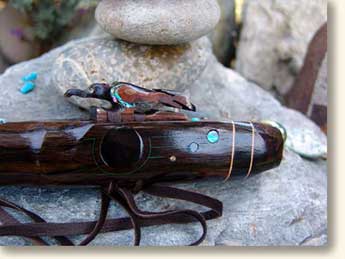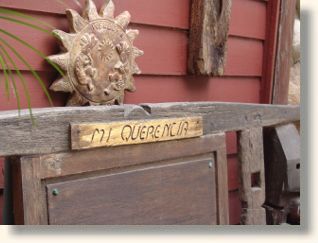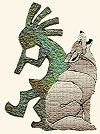Contact Info
Should you have any questions, comments or suggestions, or care to discuss building a custom flute, please don’t hesitate to contact me at QuerenciaFlutes@aol.com or 310.755.5078.
Recording artist Bill Leyden plays his composition “Querencia” with one of my flutes. Enjoy!
About The Builder
Welcome to Querencia Woodwinds, and thank you for visiting. My name is Rich Halliburton and I’m a builder of woodwinds, specifically concert quality reedless flutes. These instruments are fipple flutes by design, and have been seen in many forms worldwide since roughly 81,000 BC (Slovenia). Since almost all primitive cultures had a fipple flute, it is widely held that this design represents the first pitched flute-type in existence. I characterize mine as North American, with materials and design inspired by my love of Southwestern art and culture. In crafting these instruments, one at a time, I strive to address the voicing demands of recording artists, and appeal to the tastes of flute enthusiasts, and art collectors as well.

I have been playing these instruments for about 26 years, initially practicing in empty parking structures. My work is now done with cordless amplification and digital sound processing. About 17 years ago I began playing with a group of professional drummers and percussionists. Volume was never a serious issue with flute makers at that time, but I needed voice and volume to compete with the wall of sound created by the drummers. So I started building my own flutes. Specifically, I began creating large bore, short barrel instruments, experimenting with fifteen different woods, in search of clarity, volume and beauty.
The joy of playing these instruments was soon eclipsed by the joy of building them. Starting with a chaotic formula of woods and materials, my satisfaction comes from turning each assemblage of materials, into a finely choreographed visual and auditory dance. Creating an instrument with these characteristics…out of a stick…has become a passion, and I have come to appreciate and understand the unique attributes of every wood and accent material I use.

About the Instruments
Click here to see flutes for sale.
Each flute is one of approximately 15 built each year, by hand, one at a time. Each requires from ten days, to over a month to complete based primarily on the wood’s willingness to become a flute, and presentation or visual detailing. Every project is a blending of organic beauty and my attempt at musical perfection. To that end, and with no regard for cost, I search for and acquire the most exotic natural materials available on Earth. Both the enthusiast and serious collector will appreciate instruments handcrafted from Cuban giant hibiscus, Laotian and Cambodian flamewood, Peruvian huangana negra, Philippine paldao, Honduran mahogany, California buckeye burl, Oklahoma red cedar, and 50,000 year old New Zealand kauri bogwood.
My extensive use of burl woods like SE Asian amboyna, cinnamon, box elder and buckeye require crushed stone to fill the root voids. These include Ethiopian jasper, turquoise from the Sleeping Beauty mine in Globe, AZ, crushed Arizona chrysocolla and malachite, as well as powdered bone, pipestone, lapis, and 23kt gold. My fascination with Earth’s beauty, expressed through her raw materials, provides an ever expanding source of possibilities for my instruments.
Tuning begins with a non contact laser thermal gauge to insure the wood temperatures approximate the required ambient temperature of 72 degrees F. Tuning is thereafter accomplished using analog, digital and strobe tuners. Before applying a finish, the sound and compression chambers have to be recessed for inlay. The inlay and accent stones are chosen for color and texture, to visually tie all of the elements together. The materials can include Queensland, Andamooka and Lightning Ridge Australian boulder opals, Magdalena Cantara Mexican boulder opals, Mexican crazy lace agate, conflict-free African black and cognac faceted diamonds, Old Tibetan turquoise, paua abalone, 70 million year old Bear Paw ammolite, Brazilian azotic topaz, and milled, acid etched disks of meteorite…and the list goes on. Again, these materials represent just a sampling of the colors and textures I find necessary to complete the visual story I want to create with each instrument.
Each flute carries detailed documentation noting sizes, cuts and origin of every material used in its creation. No two instruments are alike, and each is signed and numbered, with a corresponding file maintained at Querencia Woodwinds.
Lastly, my dedication to this passion allows me to confidently stand behind each instrument with a 100% guarantee as to materials and workmanship.
Stone inlay varies from flute to flute. Unless there is a specific request, I usually pick stones I find complement specific woods, such as turquoise, paua abalone, opal, conflict-free diamonds, ammolite, lace agate, jasper, and whatever else I feel adds to or enhances the instrument.
About The Creative Process
Having been a mildly successful fine artist for about 30 years, each work was initiated with a plan to try something new and inventive. Following an exhibit at the Huntington Museum in Pasadena, an art critic for the Los Angeles Times was motivated to note, “Mr. Halliburton is still experimenting. To that end, those who view his work may not know it’s his.” He then characterized the work as “sentimental surrealism.” I thereafter figured out that creative predictability was a conflict in terms, and that experimentation is a key element to the creative process. A painting is what it is. It is hung on a wall. I find flutebuilding provides about six different opportunities for creative experimentation. From selection of woods, to placement of grain, to inlay, fetish, pyrographics, and ultimately sound. It can still be hung on a wall, but unlike a painting … it’s a stick that makes music. In crafting flutes, the only predictability I strive for is quality in my experiments.

About Querencia
About twenty years ago, I carved “Mi Querencia” into a weathered piece of oak, and nailed it to the front of my home. It is Spanish, relatively obscure, and not easily defined. Loosely, it describes a place in your heart, a place that generates a sense of safety and security, but a place that is in fact, neither safe, nor secure. An example occurs during the last few minutes of a bullfight. The bull, after being prodded and taunted, will trot around the ring, and then just stop. He will stand still there in the ring, at that spot, because for no particular reason, he feels safe, and protected. Likewise, cattle, when allowed to roam and graze, will pick a spot that gives them a “sense” of security. In reality, the chosen spot is no more secure than anywhere else, but it “feels” right.
I found that playing flutes, and building flutes … just feels right. It generates a sense of calm, security, and harmony from somewhere inside. Basically, it’s a sense … that makes no sense. I strive to share this with you, which makes perfect sense.
Rich Halliburton
